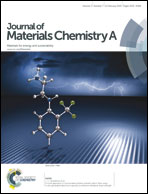Polymorphisms and morphological studies of a difluorobenzothiadiazole conjugated copolymer with 7.8% polymer solar cell efficiency†
Abstract
This study presents the structural characterization of a 5,6-difluorobenzo-2,1,3-thiadiazole (FBT)–quaterthiophene (Th4) alternating copolymer (PTh4FBT) and how the crystalline nature of PTh4FBT affects the PTh4FBT–PC71BM morphology and the device performances. The single crystal structure of 5,6-difluoro-4,7-di(thiophen-2-yl)benzothiadiazole (Th2FBT) first confirms the low conformational preference of the FBT containing molecule. Since the crystallization process does not assist in unifying the conformation of Th2FBT, both intrachain conformation and interchain c-shifts in the crystalline state of PTh4FBT have to be scrutinized. By comparing the 2D WAXS pattern of PTh4FBT and the simulated patterns generated from Cerius2 molecular modeling, it was found that the diffraction pattern generated from the lattice containing PTh4FBT with anti-conformation and limited interchain c-shift matches best with the experimental one. The face-to-face interchain stacking of PTh4FBT rendered strong crystalline nature to the polymer and caused large segregation in the PTh4FBT–PC71BM blend system, which was indicated by the TEM and GI WAXS morphological studies. The aggregation size was reduced via the use of the 1-chloronaphthalene additive. The optimized morphology led to improved Jsc and FF. The single-junction PTh4FBT–PC71BM based polymer solar cells deliver a high PCE of 7.75% with a Voc of 0.76 V, a Jsc of 14.36 mA cm−2, and a FF of 71.0%.


 Please wait while we load your content...
Please wait while we load your content...